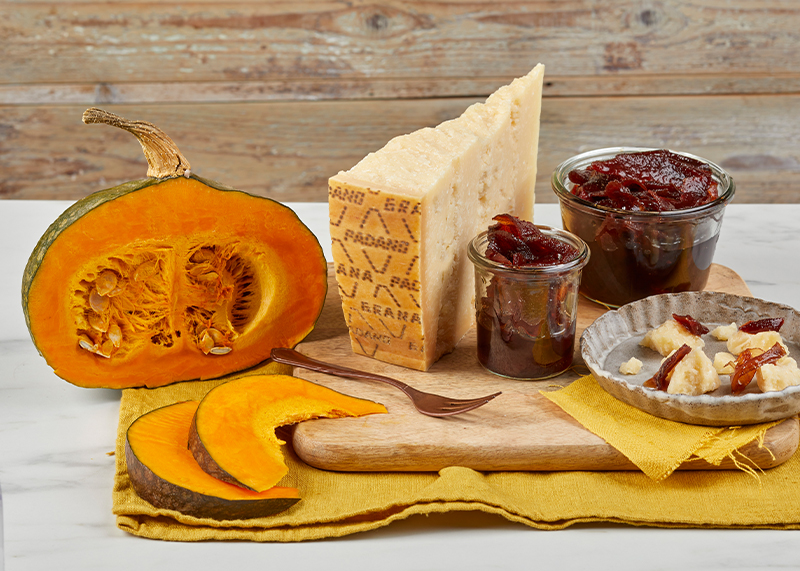
Grana Padano PDO 16-20 months
Grana Padano PDO 16-20 months and Quince mostarda
This can be considered the mother of all mustards and has always been produced in Mantuan households.
It has a rather crunchy texture and an intense flavour; it has the ability to deeply absorb the mustard essential oils so it should be served by opening the packet about ten minutes before serving to allow it to breathe and reduce its intensity on the nose.
We suggest pairing it with Grana Padano 16-20 months, but it also goes well with cheeses aged for longer, even beyond 24 months.
In this combination, one appreciates the crunchy structure of the quince, which adapts to and supports the harder, grainier structure of this type of cheese; the spiciness of the preparation is very important, but the two products nevertheless follow each other pleasantly, and the intensity of flavour of this Grana Padano alternates with that of the mostarda, allowing one to appreciate both.
Curious facts:
- The quince (Cydonia oblunga) does not belong to either the apple or the pear tree families, but is a separate species. However, they are actually all closely related: they all belong to the Rosaceae family and come under the Pomoideae subfamily whose fruit (pome) originates from the receptacle (the enlarged end part of the pedicel of the flower). It is therefore a ‘false fruit’, i.e. a structure that is not derived from the pistil (the female part of the flower). Inside the flesh there is a 5-cell ovary containing the seeds.
The shape of the fruits of different quince varieties often causes confusion, as they can resemble those of the apple and pear trees. Undoubtedly, the quince can rightfully claim a place in the category of ‘forgotten fruits’: cultivated since antiquity – it is no coincidence that the botanical name of the genus derives from that of a city in ancient Greece – it has not spread as extensively as other fruit species. Nowadays, it is in fact little known, and in fact the tree is often mistaken for a variety of apple or pear tree when, in fact, it belongs to a separate species and is classified in a different genus.

Grana Padano PDO 16-20 months and Pumpkin mostarda
The pumpkin is one of the symbols of Mantua. It is grown in large quantities in the Mantuan area and is considered the ‘pig of the garden’ because every single piece of it is used. The main cultivars grown are Violina, Marina di Chioggia or the local version of the American pumpkin, mainly traded outside the province. The type most commonly used in the Mantuan area today is the old version known as ‘Cappello del prete’ or the new one (made with the ‘Delica’ cultivar). It is used in soups, fried or as an ingredient of the famous ‘Tortelli di zucca alla mantovana’ (Mantuan-style pumpkin tortelli), as well as for the preparation of ‘mostarda di zucca senapata’ (mustard-soaked pumpkin mostarda).
The art of making vegetables into mostarda requires particular dexterity and some Mantuan families, who are still the custodians of this technique, know how to handle pumpkins with great skill and excellence: this is a unique example of that is only found in Mantua, and it has been the case for decades.
The pumpkin, once processed to become mostarda, is bright orange in colour, thinly sliced or diced, and slightly crunchy with a tender centre; in some cases it is also used mixed with apple, but mostly it is found on its own. It pairs perfectly with Grana Padano PDO with a medium ageing period of from 16 to 20 months. In this case, the combination works due to the contrast between the sapidity of the cheese and the sweetness of the pumpkin; in addition, the texture of the pumpkin, which varies according to the type of cut, always presents a crispier exterior alongside a softer one; this characteristic results in an intriguing interplay in the mouth with the texture of the 16-20 month Grana Padano shaving.
